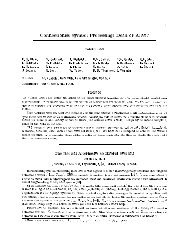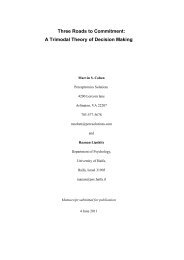Three Roads to Commitment: A Trimodal Theory of Decision Making
Three Roads to Commitment: A Trimodal Theory of Decision Making
Three Roads to Commitment: A Trimodal Theory of Decision Making
Create successful ePaper yourself
Turn your PDF publications into a flip-book with our unique Google optimized e-Paper software.
<strong>Three</strong> <strong>Roads</strong> <strong>to</strong> <strong>Commitment</strong>: A <strong>Trimodal</strong> <strong>Theory</strong> <strong>of</strong> <strong>Decision</strong> <strong>Making</strong> 50<br />
Control. Aids should help users adapt <strong>to</strong> constraints <strong>of</strong> time and stakes. This includes reducing risks by<br />
increasing the robustness <strong>of</strong> courses <strong>of</strong> action (Forestalling), reducing the cost <strong>of</strong> delaying irreversible commitment<br />
(Buying time), and acting immediately on the current best solution when benefits <strong>of</strong> further risk reduction are<br />
outweighed by the costs <strong>of</strong> delay (the Suppress tactic).<br />
Transitions. Displays for different modes should support seamless transitions <strong>to</strong> other modes when appropriate.<br />
For example, displays for creating options and goals (matching) should relate transparently <strong>to</strong> displays for<br />
comparing options in terms <strong>of</strong> goals (when choice is appropriate), and both should relate transparently <strong>to</strong> displays<br />
for vetting courses <strong>of</strong> action before implementation and for moni<strong>to</strong>ring goal achievement during implementation<br />
(reassessment).<br />
Uncertainty. Aids should focus on the appropriate intersection <strong>of</strong> decision mode and action uncertainty. Issues<br />
relevant <strong>to</strong> the decision mode should be highlighted as discussed under Focus, e.g., obstacles in determining rule fit<br />
in matching, option efficiency in choice, and course <strong>of</strong> action reliability in reassessment. Variations in levels <strong>of</strong><br />
action uncertainty across problems and users should be accommodated, e.g., pattern recognition tactics should be<br />
reserved for the lowest levels <strong>of</strong> action uncertainty; weak methods and lengthy reasoning processes should be<br />
reserved for the highest levels <strong>of</strong> action uncertainty; strategies for adaptive deliberation should be supported for<br />
moderately difficult problems in familiar domains. Displays should seamlessly track uncertainty levels as they<br />
change in response <strong>to</strong> uncertainty handling tactics; for example, affording users the opportunity <strong>to</strong> evaluate and<br />
modify peripheral assumptions in cases <strong>of</strong> low action uncertainty, or more central ones if overall implausibility<br />
increases.<br />
The standard s<strong>to</strong>ry, which identifies decision making with choice, encourages people <strong>to</strong> make retrospective<br />
sense <strong>of</strong> their actions <strong>to</strong> themselves and others as deliberate and optimal (March, 1979) – and conversely, <strong>to</strong> fault<br />
others’ decisions for not achieving the same perfection. This s<strong>to</strong>ry is an ideal congealed in<strong>to</strong> a cultural myth. It has<br />
also proven <strong>to</strong> be a trap for designers, who are still capable <strong>of</strong> being surprised by the low level <strong>of</strong> user acceptance<br />
even for well-engineered decision support, when it focuses exclusively on deliberative comparison <strong>of</strong> options.<br />
<strong>Trimodal</strong> <strong>Decision</strong> <strong>Making</strong> insists on the normative validity <strong>of</strong> three paths <strong>to</strong> commitment, describes different levels<br />
<strong>of</strong> affordance for those paths, and prescribes principles <strong>of</strong> decision aiding. It fleshes out and corrects the standard<br />
s<strong>to</strong>ry and other overly narrow approaches <strong>to</strong> decision making, and, we hope, will be a useful source <strong>of</strong> implications<br />
and challenges for cognitive engineering practice and research in the future.<br />
REFERENCES




